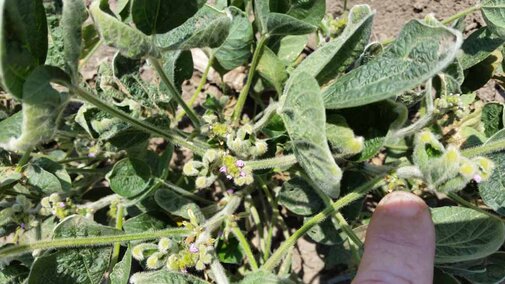The herbicide dicamba has been used for over 50 years, but until recently, it was primarily used in Nebraska roadsides, grass-based range or pastures, and corn/ sorghum crops. The recent development of dicamba-resistant soybean varieties, known as Roundup Ready 2 Xtend® soybean, now allows higher dicamba doses to be used for weed control in fields planted with these soybean varieties.
Among all dicot species, soybean is exceptionally sensitive to dicamba-induced leaf injury, even at low doses. Ironically, most dicot weeds show no leaf injury at low doses, and thus require high dicamba dose rates to effectively control them. With the increase of off-target herbicide damage to non-Xtend soybean the past two years, this article seeks to explain how different growth regulator herbicides work and their associated symptoms.
There are now five structurally different growth regulator herbicides classified by weed scientists as Group 4 synthetic auxins. One is dicamba which has the chemical structure of 3,6-dichloro-2-methoxybenzoic acid. Another is 2,4-D, which has the chemical structure of 2,4-dichlorophenoxyacetic acid. The other three have pyridinecarboxylic acid, pyrimidinecarboxlic acid, and quinolonecarboxylic acid structures. (These are not commonly associated with off-target herbicide drift in Nebraska, so we will not discuss them here.) Picloram, a pyridinecarboxylic acid, is used for dicot weed control in Nebraska pastures and rangeland. It has a lengthy half-life, and long-term picloram persistence in the soil and in monocot plants grown on that soil are of concern. A good discussion of Group 4 herbicide presence in plant residues (straw/hay, manure, and compost) can be found in this article from Virginia Tech University.
The natural auxins in plants regulate the precise temporal (developmental) and spatial (anatomical) occurrence of cell division in the leaflet, as well as the subsequent transition from cell division to cell expansion, as described in this review of the molecular biology and genetics of plant leaf development (Bastidas et.al, 2008). In dicots synthetic auxins disrupt natural auxin control of cell division/expansion, leading to distorted leaf morphology at low doses (and plant death at high doses). This is why they are useful herbicides for controlling dicot weeds.
The soybean leaflet is botanically characterized as having an ovate shape. (For example: see the upper left leaflet bounded by the two ink pens in Figure 1). Low-dose exposure of conventional soybean varieties to dicamba, or to 2,4-D, will distort that ovate leaflet shape; however, the type of malformation induced by these two synthetic auxins is quite different in low-dose applications.
Also see:
Are Your Soybean Plants Exhibiting Dicamba-Induced Leaf Injury?
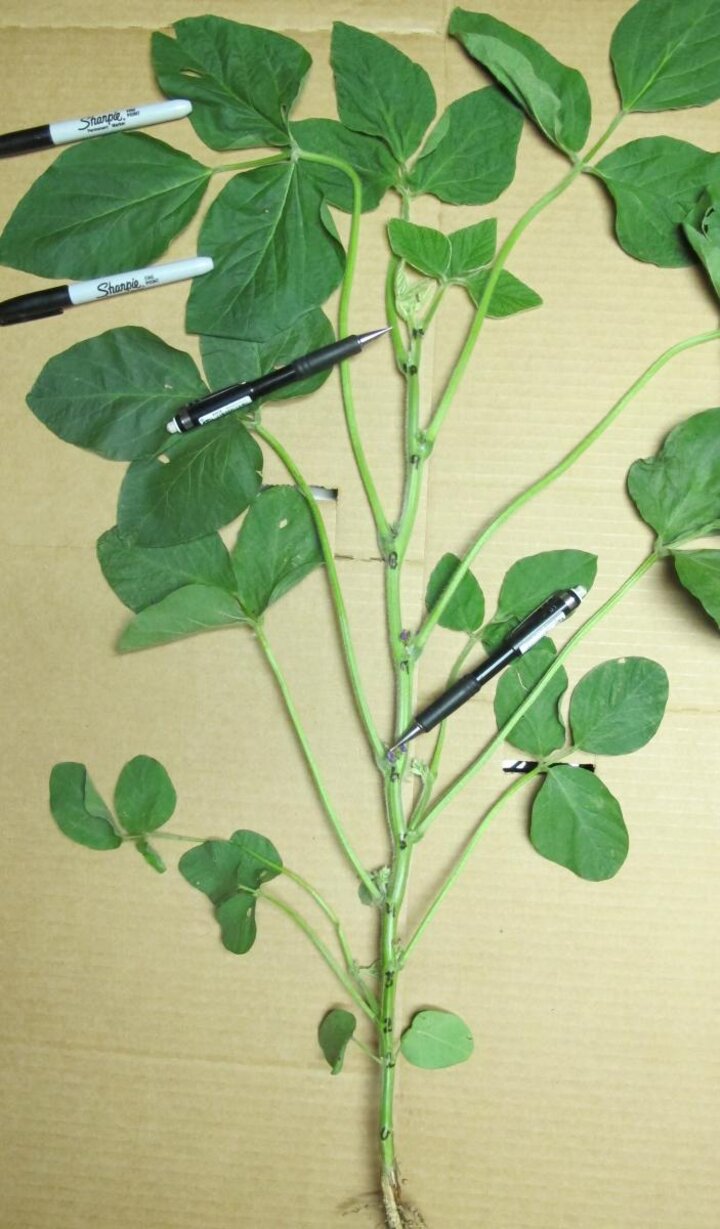

Figure 2. These nearly fully developed trifoliolate leaflets were directly exposed to dicamba before cell division at the upper leaflet margins had been completed. Because dicamba negatively affects leaflet margin cell division, direct dicamba exposure to these leaflets resulted in a “draw-string” injury symptom at the leaflet tips, thus shortening the leaflet length.
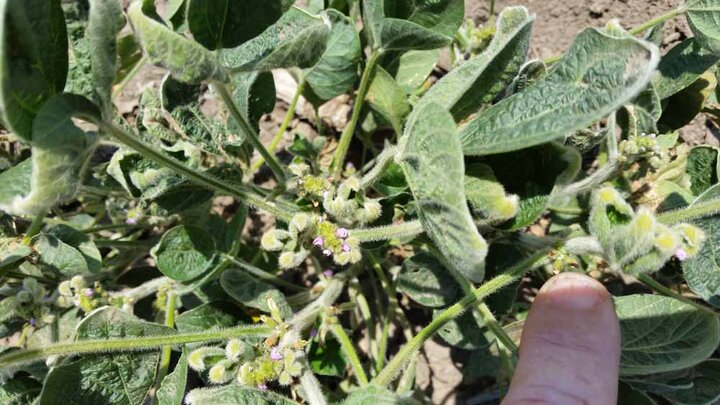
Figure 3. Leaflet cupping injury that occurred in younger soybean leaflets still undergoing cell division at the entire leaflet margin when directly exposed to dicamba. Keep in mind, however, that the translocation of dicamba from directly exposed leaflets to very young leaf primordia developing at new nodes at the main stem apex will also induce leaf cupping in those yet to emerge leaflets, even though these very young leaflet primordia were not directly exposed to dicamba. The same can be true for new trifoliolates occurring from additional stem branching at lower nodes.
Dicamba impacts cell division areas located at the leaf margins. In older, fully developed and expanded leaflets located at nodes nearer the base of the soybean main stem, cell division will have ceased; thus, leaf malformation will not occur upon direct exposure of these leaflets to dicamba. However, in leaflets not yet fully developed, cell division will have ceased along most of leaflet margins except at the leaflet tip. If so, the classic dicamba leaf-cupping symptom will be limited to just the leaflet tip, which will take on a “drawstring bag” shape, and the tip will be brown or cream colored (Figure 2).
In younger, much less developed leaflets at nodes nearer the top of the main stem, cell division will occur in most leaflet margin regions and, for very young leaflets, will occur along the entire circumference of the leaflet margin. Exposure of these very young leaflets to dicamba will generate a more severe form of the classic dicamba-induced cupping injury, in which the leaflet margins will be tightly rolled inward (Figure 3). In some cases, strongly cupped young leaflets also may exhibit a bullate leaf surface ― a botanical term describing the presence of rounded or globular bumps on the upper leaf surface.
Ordinarily, dicamba exposure leads to upwardly cupped leaflets, and severely so, in dicamba-injured younger leaflets (Figure 3). However, when dicamba-induced cupping is limited to just the leaflet tip, the cupping can be either slightly curved upward or slightly curved downward (Figure 2). Slight physical forces occurring in wind-blown canopies can cause a concave and convex cupped older leaflet to interconvert. You can observe this concave or convex cup-shape convertibility by applying light finger pressure to the slight cupped leaflet “bottom”. Observers have noted both upward and downward leaflet cupping in dicamba-injured older leaflets, but only upwardly-cupped leaflets in younger leaflets (Figure 3).
Unlike dicamba, 2,4-D impacts cell division in the more central (major vascular) portion of the leaflet. Low-dose 2,4-D exposure induces injury that results in a “narrowed, strap-shaped" leaflet in which the leaflet veins are made more parallel. This 2,4-D-induced injury is often accompanied by a rugose leaf surface ― a botanical term describing a rough leaf surface of irregularly spaced bumps/wrinkles and prominent ridged/corrugated leaf veins.
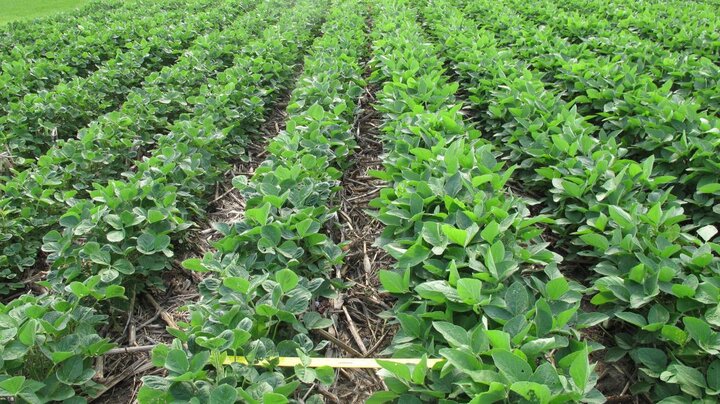
Figure 4. Adjacent eight-row strips of dicamba-susceptible (left) and dicamba-resistant (right) MG 2.4 cultivars planted on May 23, 2018. Photo was taken on July 5, 2018, about two weeks after a dicamba off-target drift exposure incident.
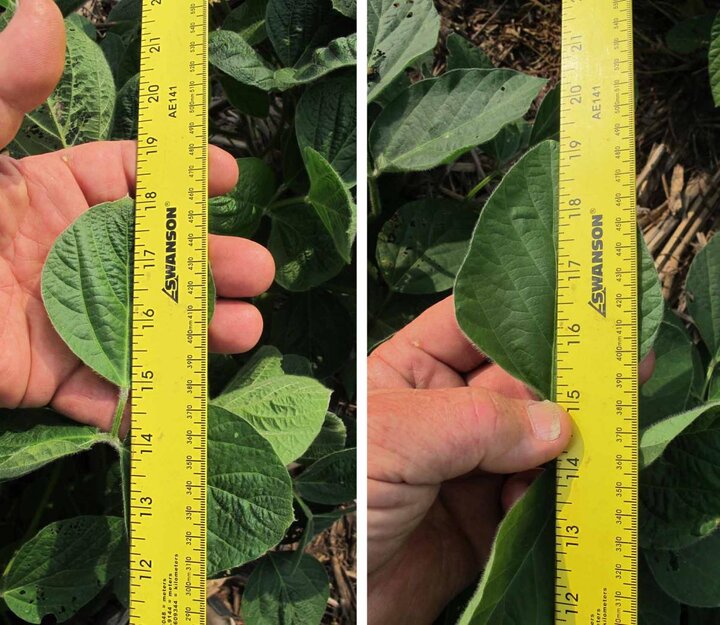
The cupped leaflets arising from a low-dose dicamba exposure will be visibly shorter compared to non-injured normal ovate leaflets at the same node, leading to reduced leaflet area and slowing the advance to canopy closure (Figures 4 and 5). Low-dose 2,4-D exposure will also lessen leaflet area, but differently, by narrowing/elongating the leaflet. Low-dose dicamba- (or 2,4-D-) injured older leaflets cannot recover from this leaf area loss because cell division cannot restart in those leaflets. Reduced leaflet area can affect timing of canopy closure and perhaps impact weed control.
Unlike 2,4-D, dicamba is highly translocatable, even at low exposure doses (Figure 3). Dicamba applied as one- or two-spray droplets to a given leaflet can easily move to young leaflets developing at main stem nodes above that dicamba-impacted leaflet node. In fact, this translocation ability can lead to dicamba-induced leaflet-cupping injury in upper young leaflets that were not even directly exposed to dicamba spray droplets because the very young leaf primordia at the stem apex were tightly enclosed by older developing leaflets that provided protection from same-day applied spray droplets. This developmental succession of nodal leaf development is why easily translocatable dicamba can induce injury in leaflets located at several successive main stem nodes, and why it is an effective dicot weed-killer at higher doses.
References
Bastidas, A.M., T.D. Setiyono, A. Dobermann, K.G. Cassman, R.W. Elmore, G.L. Graef, and J.E. Specht. 2008. Soybean sowing date: The vegetative, reproductive, and agronomic impacts. Crop Science 48:727-740.
2,4-D Technical Fact Sheet, National Pesticide Information Center
Dicamba Technical Fact Sheet, National Pesticide Information Center
Fehr, Walter R. and Charles E. Caviness. 1977. Stages of soybean development. ISU Special Report 87.
Herbicide Classification Chart, United Soybean Board, Take Action Herbicide-Resistance Management.
Injury from 2,4-D Growth Regulator, Purdue University.
Injury from Dicamba Growth Regulator, Purdue University.
Plant Injury from Herbicide Residue, Virginia Tech University, discusses the persistence of growth regulator herbicides in soil and in plant residues.
SoySim. University of Nebraska-Lincoln Soybean Growth Simulation Model
